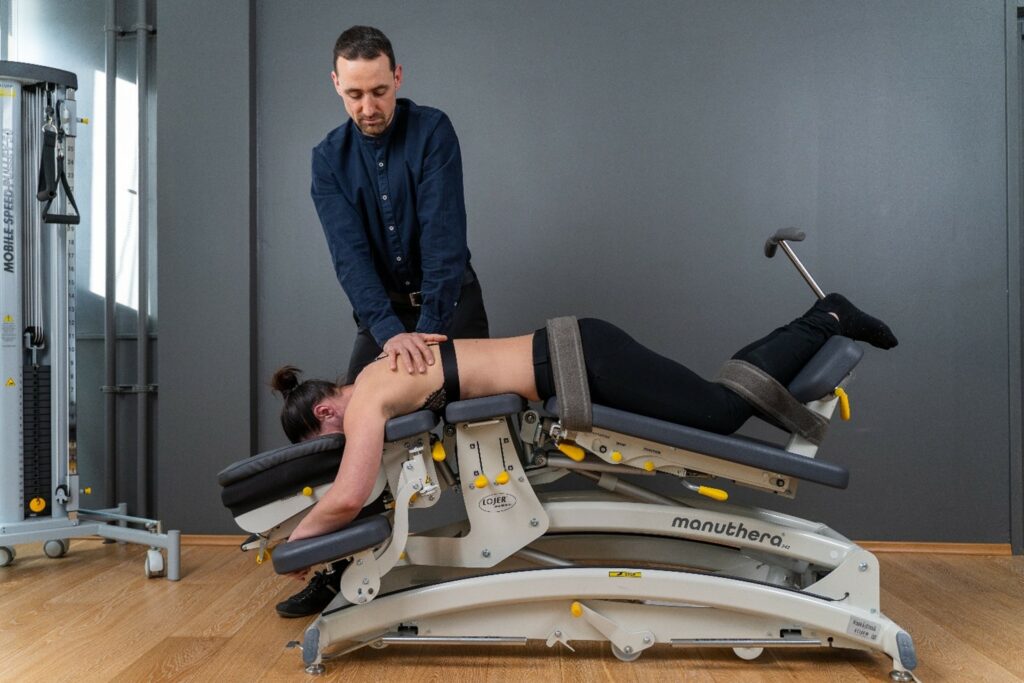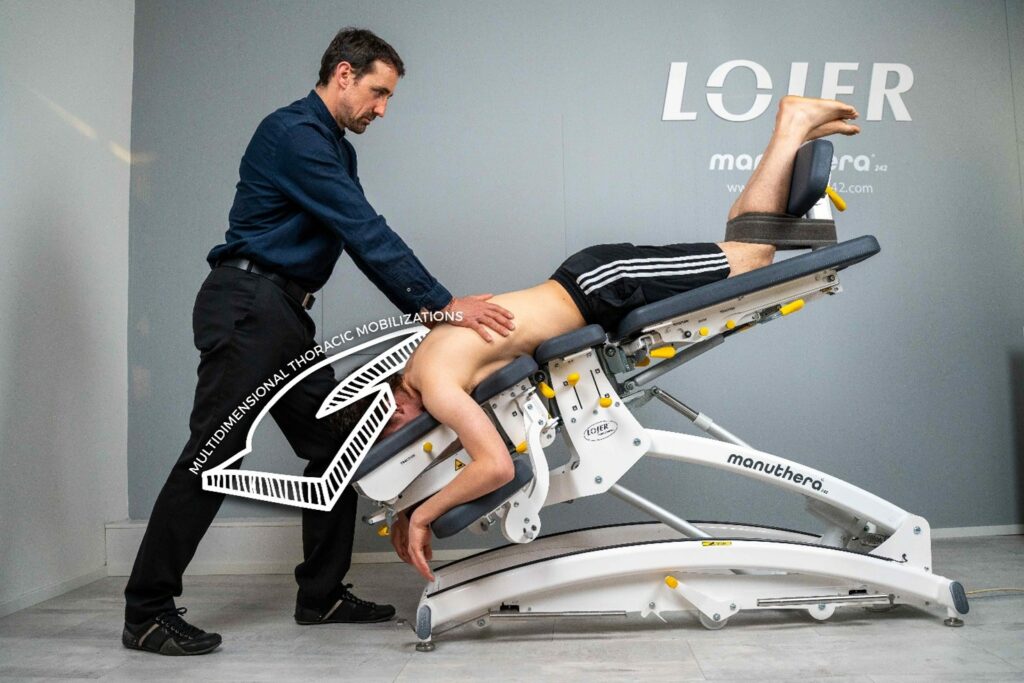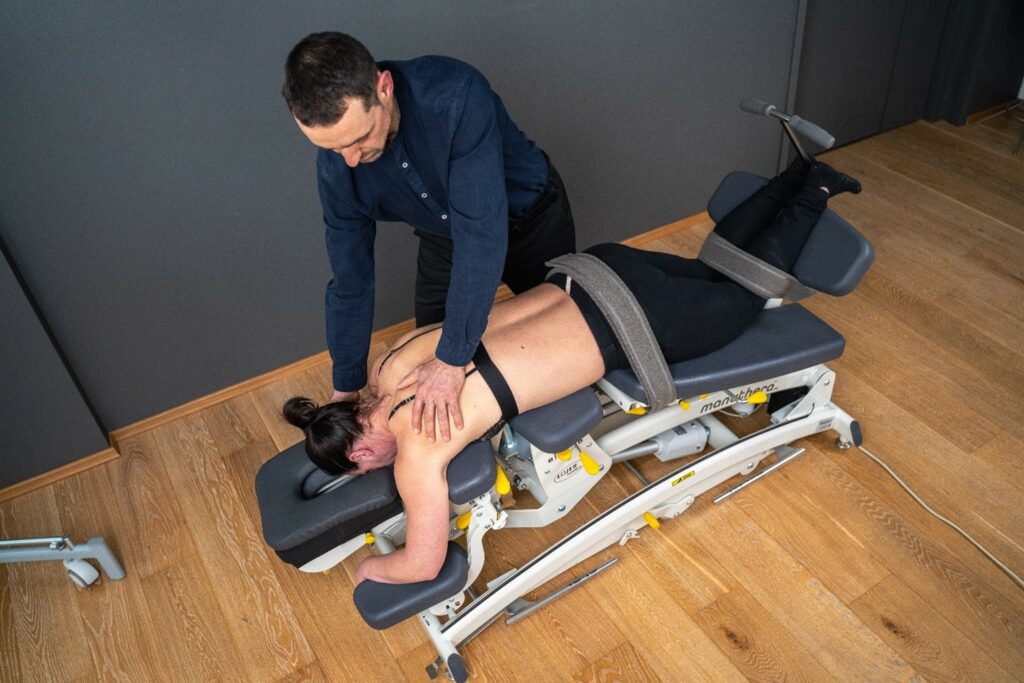The thoracic spine, located in the upper back, plays a crucial role in maintaining proper posture and movement throughout the body. However, due to poor posture, lack of movement, and sitting for extended periods, the thoracic spine can become stiff and immobile. This can lead to different kind of issues, including back pain, poor posture, and even headaches.
Fortunately, thoracic spine mobility can be improved through regular stretching, exercises and/or mobilization/manipulation done by a trained professional. In this post, we’ll explore the anatomical structure of the thoracic spine, benefits of thoracic spine mobility and what kind of benefits can Manuthera 242 offer for trained professionals.

The thoracic spine is made up of 12 vertebraes, which are separated by intervertebral discs. The thoracic spine also has several joints, including the costovertebral and costotransverse joints, which allow for movement in the upper back. The thoracic spine also has several muscles, including the trapezius, rhomboids, and latissimus dorsi, which help with movement and stability. Thoracic spine is directly connected to the ribs and torso area, which means that its limitations and immobility effects directly to breathing and other important activities of the body.
A mobile thoracic spine can help improve posture by allowing the shoulders to sit back and down, and the chest to open up. Stiffness in the thoracic spine can lead to pain in the upper and lower back. By increasing thoracic spine mobility, you can reduce the stress on these areas and alleviate pain. A mobile thoracic spine allows for a greater range of motion in the upper body, making daily activities and exercises easier. The thoracic spine plays a role in the mechanics of breathing. Improving thoracic spine mobility can help improve the efficiency of the respiratory system. Tightness in the thoracic spine can lead to tension headaches. By increasing thoracic spine mobility, you can reduce the frequency and intensity of headaches.
Mobilizating and manipulating of the thoracic spine with Manuthera 242
Mobilization and manipulation of the thoracic spine by a professional trainer, such as a chiropractor, osteopath or physiotherapist, can help alleviate these issues and improve overall spinal health. As mentioned earlier a mobile thoracic spine can help improve posture by allowing the shoulders to sit back and down, and the chest to open up. A professional trainer can use mobilization techniques to help release any tightness or stiffness in the thoracic spine, leading to improved posture. With the Manuthera 242 table, trained professional can move the spine with the table and work on the tight and stiff areas at the same time. This allows professional to combine the movement with the chosen mobilization technique.
Stiffness in the thoracic spine can lead to pain in the upper and lower back. A professional trainer can use Manuthera 242 to release any tightness or stiffness in the thoracic spine, reducing the stress on these areas and alleviating pain. We can flex, extend or side bend the thoracic spine with the Manuthera to access the targeted area from the right and optimal angle.

A mobile thoracic spine allows for a greater range of motion in the upper body, making daily activities and exercises easier. Manuthera combined with a trainer professional user is a perfect match when the patient is suffering from limited range of motion. We can access the vertebraes, facet joints, the ribs and surrounding soft tissues more easily when the versatility of Manuthera is in our hands.
The thoracic spine plays a role in the mechanics of breathing. Now after two years of CoVid-pandemic going around the world, breathing limitations and therapy for it is more common than ever before. Improving thoracic spine mobility can help improve the efficiency of the respiratory system. One of the key goals of manipulation of the thoracic spine is to help promote relaxation and reduce stress levels. Benefits of thoracic spine manipulation include reduced pain and inflammation, improved function, enhanced performance and promote relaxation.
It is important to note that mobilization or manipulation of the thoracic spine should only be performed by a qualified and trained professional, such as a chiropractor, osteopath or physiotherapist. These professionals have the knowledge and skills necessary to safely and effectively mobilize and manipulate the thoracic spine, ensuring the best possible outcome for the patient.

Examples for different techniques a trained professional can use on Manuthera 242 for thoracic spine issues
- High-Velocity Low-Amplitude (HVLA) Thrust: This is a quick and precise movement that aims to restore normal movement and alignment to the joint. The practitioner will use their hands to deliver a high-velocity, low-amplitude thrust to the joint in order to move it beyond its normal range of motion.
- Myofascial Release: This technique aims to release tension in the soft tissue (muscles, tendons, and fascia) surrounding the thoracic spine. The practitioner will use their hands to apply pressure to specific areas, such as knots or trigger points, in order to release tension and improve mobility.
- Mobilization: This technique aims to improve the movement of the thoracic spine by moving it in different directions. The practitioner will use their hands to guide the spine in different directions and hold it in specific positions in order to improve mobility.
It is also important to note that before starting any mobilization or manipulation, the practitioner will interview, perform an assessment of the patient’s condition, including taking a medical history, making a physical examination, and in some cases possibly ordering imaging tests to identify the cause of the problem and to determine the best course of treatment
Don’t let stiffness in your upper back hold you back any longer. Unlock the full potential of your thoracic spine with mobility exercises and professional manipulation and mobilization. Contact a trained professional with Manuthera 242 near you today to schedule your appointment and start feeling better.



